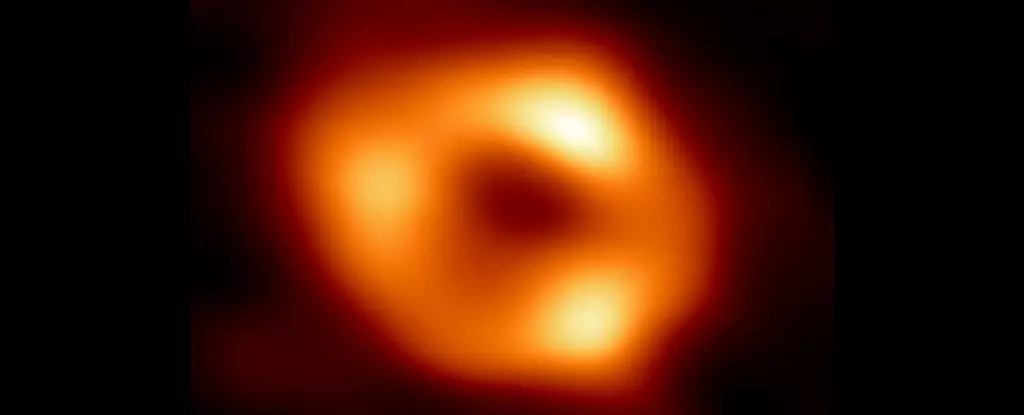

The heart of the Milky Way galaxy, home to the enigmatic black hole Sagittarius A* (Sgr A*), has captivated scientists and the public alike since the release of its first direct image by the Event Horizon Telescope (EHT) in 2022. While the initial image showcased a bright circular ring surrounding a darkness that signified the black hole, a recent study by researchers at the National Astronomical Observatory of Japan (NAOJ) has cast a different light on this celestial mystery. Their findings suggest that the accretion disk surrounding Sgr A* might possess a more elongated shape, rather than the spherical appearance that has permeated scientific discussions since the EHT’s groundbreaking release.
The process of capturing and portraying astronomical objects is fraught with complexities, particularly when utilizing radio interferometry, a method that combines data from multiple telescopes to create a singular image. The EHT network, consisting of eight terrestrial radio antennas, produced a compelling yet simplified view of Sgr A*. However, NAOJ scientists employed alternative analysis techniques, leading them to question the accuracy of the EHT’s findings. According to NAOJ astronomer Miyoshi Mikato, the circular ring structure may not purely reflect the black hole’s morphology but instead could represent an artifact of the imaging analysis itself.
Mikato posits that the round appearance observed in the EHT’s photo may stem from incomplete data processing, where subtleties in actual physical geometry were lost in translation. The different approaches underscore a broader theme in contemporary astronomy: the interpretation of data is often as vital as the data itself. In the quest to map the cosmos, multiple viewpoints can yield varying insights, leading to a richer understanding of celestial phenomena.
So what did the NAOJ team discover in their exploration of Sgr A*? Their results revealed an elongated image, predicated on observations suggesting that the eastern hemisphere of the accretion disk shines more brightly than the west. This asymmetry could be attributed to the accretion disk’s rotation, which the NAOJ team estimates occurs at a staggering sixty percent of light’s speed. With material swirling in high velocities around the black hole, friction and magnetic forces contribute to heating this disk, resulting in x-ray and radio emissions that signify intense energy interactions.
This dynamic activity not only supports an elongated morphology for the disk but also raises significant questions regarding the intrinsic characteristics of black holes themselves. The interpretations of both the EHT and NAOJ highlight the influence of gravitational forces on the matter circulating near black holes, suggesting that our previous understandings may require reevaluation in light of new evidence.
The method of analysis plays a critical role in how astronomers perceive and interpret astronomical data. The EHT’s original depiction faced challenges with several gaps in the interferometric data, necessitating special techniques to “fill in” those voids and render a complete image. The subjective nature of this process means that one can arrive at diverse conclusions based solely on methodical differences. On the other hand, NAOJ’s innovative mapping processed these gaps differently, yielding a representation that reflects a more complex structure.
In essence, both the EHT and NAOJ analyses provide valid yet contrasting insights into Sgr A*. Each study showcases the ongoing evolution of astronomical techniques and underscores the importance of refining these methodologies to produce increasingly accurate representations of the universe.
Understanding the true shape and behavior of the Sgr A* accretion disk is essential not only for grasping the nature of this particular black hole but also for crafting broader theories about the formation and evolution of galaxies. As researchers strive for more detailed imaging of Sgr A* and various other black holes, the aim is not just to enhance the beauty of celestial images but also to yield deeper insights into the fundamental mechanisms underlying black hole dynamics and cosmic evolution.
The revelations regarding Sgr A* from both analyses signify a noteworthy milestone in astrophysical research. As the Event Horizon Telescope Consortium continues to advance its techniques and technologies, the spectacle surrounding our galaxy’s supermassive black hole promises to evolve, welcoming new revelations that could reshape our understanding of the universe’s most elusive inhabitants.
The journey to accurately capture and interpret the imagery from Sgr A* serves not merely as an illustration of the complexities faced in astrophysical research, but also as a reminder of the beauty and intricacy of the universe we all share. Each new finding adds a layer to our understanding, enriching the narrative of our cosmic heritage.
Rogue waves have long been a subject of fascination and terror in maritime lore. These…
As the world grapples with public health challenges, especially those posed by infectious diseases, the…
The Sombrero Galaxy, also known as Messier 104, embodies a breathtaking blend of spirals and…
In recent advances in quantum electronics, a groundbreaking discovery leveraging the concept of kink states…
In the intricate tapestry of nature, ice often exists in a delicate balance with liquid…
In an astonishing event that captured global attention, a rogue object from beyond our Solar…
This website uses cookies.